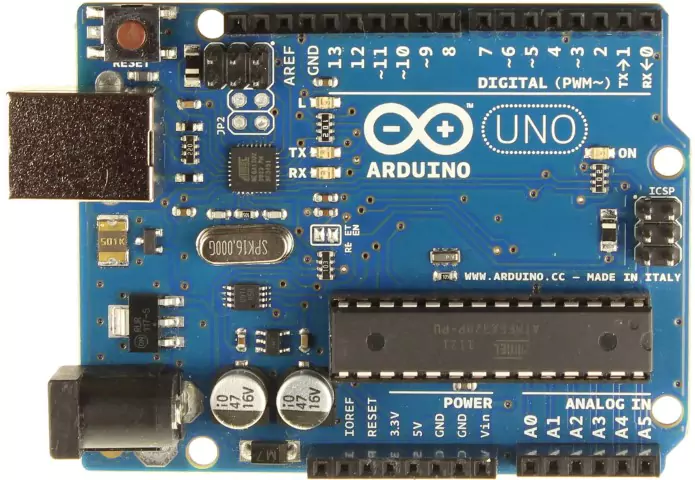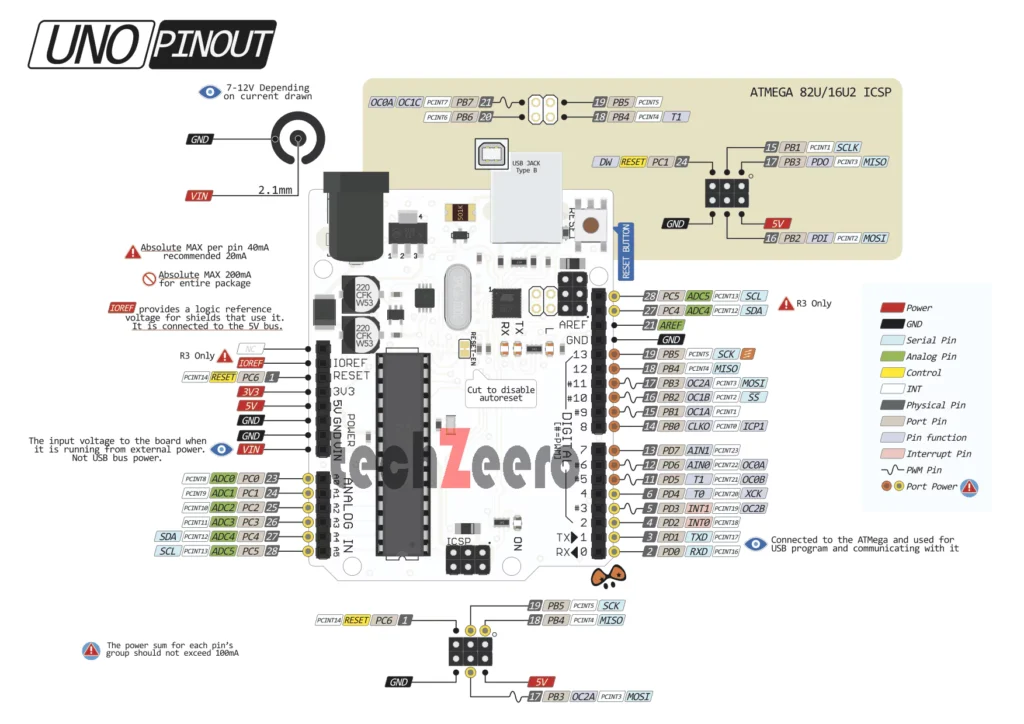What is Arduino Uno?
Arduino Uno is a popular open-source microcontroller board that has revolutionized the world of DIY electronics. It is widely used by hobbyists, students, and professionals alike for creating interactive projects, prototypes, and gadgets.
With its user-friendly interface and robust hardware capabilities, Arduino Uno makes programming easy even for beginners. Its compatibility with a vast array of sensors, actuators, and shields allows for endless customization possibilities.
Arduino UNO is based on the Atmega328P microcontroller. Arduino Uno offers 14 digital input/output pins, 6 analog inputs, a USB connection for programming and power supply purposes, a power jack to connect external power sources, and more.
Related Articles:

Arduino Uno Pinout
The Arduino Uno features a total of 20 pins that can serve various purposes, including digital input/output, analog input, power supply, and communication.
The pins on the Arduino Uno are categorized into several groups, including special function pins (RESET, VIN), power pins (5V, 3.3V, GND), digital pins (0–13), and analog pins (A0-A5). You can use pins to link sensors, actuators, displays, and other electrical components. Each pin has a unique purpose.
Out of the 14 digital pins on the board, 6 can function as PWM (Pulse Width Modulation) outputs. D3, D5, D6, D9, D10, and D11 are the PWM pins in Arduino UNO.
PWM (Pulse Width Modulation) is a technique to get analog results from digital means. PWM mainly used in Arduino for controlling Servo Motors, LEDs, Speed Controlling, etc.
You can power the Arduino UNO board either via USB connection or through the Power Jack using an external power supply. We have to use an AC to DC Adapter of 2.1 mm centre-positive plug into the board’s power jack. The board can work on an external supply of 6 to 20 volts. Using a voltage higher than 12V may lead to overheating of the voltage regulator, potentially damaging the board.

Pin Description:
- Vin:- The input voltage to the Arduino board when it’s using an external power source you can supply voltage through this pin. If the supplying voltage via USB connection or the power jack, you can access it through this pin.
- 5V: – This pin gives the output of 5V. You can use this pin to give a 5V supply to the sensor.
- 3V3:- This pin gives the output of 3.3V. The maximum current drawn is 50 mA.
- GND:- These pins use as Ground Pins.
- IOREF:- On the Arduino board, this pin provides voltage references, with which the microcontroller operates. A properly configured gradient can read the IOREF pin voltage and can work with 5V or 3.3V to select a suitable power source on the output or enable the voltage translator on the output.
Technical Specifications
The Arduino Uno is a popular microcontroller board known for its versatility and user-friendly design. When it comes to specifications, the Arduino Uno boasts an ATmega328P microcontroller running at 16MHz, with 32KB of flash memory and 2KB of SRAM.
To function, this board needs a voltage of 7 to 12 volts, which can be provided via a USB connection or an external power source. It runs on a 5V voltage. This board also has integrated LEDs for pin status monitoring and power signaling.
| Microcontroller | ATmega328P |
| Operating Voltage | 5V |
| Input Voltage (recommended) | 7-12V |
| Input Voltage (limit) | 6-20V |
| Digital I/O Pins | 14 (of which 6 provide PWM output) |
| Analog Input Pins | 6 |
| DC Current per I/O Pin | 20 mA |
| DC Current for 3.3V Pin | 50 mA |
| Flash Memory | 32 KB (ATmega328P) of which 0.5 KB used by bootloader |
| SRAM | 2 KB (ATmega328P) |
| EEPROM | 1 KB (ATmega328P) |
| Clock Speed | 16 MHz |
| LED_BUILTIN | 13 |
| Length | 68.6 mm |
| Width | 53.4 mm |
| Weight | 25 g |
Note:- Do not supply voltage via the 5V or 3.3V pins, it bypasses the regulator and can damage the board. We don’t advise it.
Why Arduino Uno is a Great Choice for Beginners
Arduino Uno is undeniably a fantastic choice for beginners stepping into the world of electronics and programming. Its user-friendly interface, extensive community support, and versatility make it an ideal platform to learn and experiment with various projects.
With its straightforward pinout, specifications, and easy setup process, it enables users to dive right into creating innovative projects without feeling overwhelmed.
Whether you are interested in robotics, home automation, or interactive art installations, Arduino Uno provides a solid foundation to bring your ideas to life.